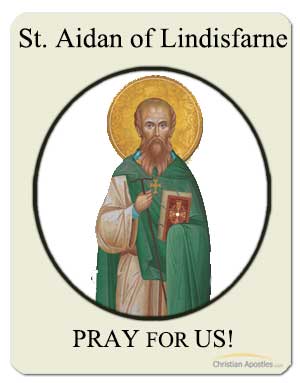Saints
St. Aidan of Lindesfarne
 Biography of St. Aidan of Lindesfarne
Biography of St. Aidan of Lindesfarne
St. Aidan of Lindesfarne (also known as St. Aidan of Iona) was an Irish monk who played a significant role in the spread of Christianity in England in the 7th century. He is venerated as a saint by the Catholic Church and is considered the patron saint of Northumbria and the Isle of Man.
Aidan was born in Ireland in the early 600s, and he received a monastic education at the monastery of Iona, located off the west coast of Scotland. After completing his studies, Aidan returned to Ireland and became a monk at the monastery of Clonfad, where he was known for his kindness, humility, and devotion to God.
In 635, Aidan was chosen by King Oswald of Northumbria to become the bishop of Lindesfarne, a small island located off the northeast coast of England. Lindesfarne was a pagan territory at the time, and Aidan’s mission was to convert the people there to Christianity.
Aidan accepted the challenge and traveled to Lindesfarne, where he began preaching and evangelizing. He was known for his gentle and compassionate approach, and many people were drawn to his message of love and forgiveness. Aidan’s efforts were successful, and he helped to establish the Christian faith in Northumbria.
Aidan was also known for his charitable works, and he established a monastery on Lindesfarne where he trained young monks in the monastic life. He was deeply committed to the monastic way of life and spent much of his time in prayer and contemplation.
Aidan’s influence extended beyond Lindesfarne, and he was highly respected by other Church leaders in England. He was also known for his ability to mediate disputes and bring peace to troubled areas.
Aidan died on August 31, 651, and he was canonized as a saint by the Catholic Church. His feast day is celebrated on August 31st by the Church of England, and he is remembered for his tireless efforts to spread the gospel and for his devotion to the monastic life.
Popular St. Aidan of Lindisfarne Rosary and Medal
Prayer of St. Aidan of Lindisfarne
Leave me alone with God as much as may be.
As the tide draws the waters close in upon the shore,
Make me an island, set apart,
alone with you, God, holy to you.Then with the turning of the tide
prepare me to carry your presence to the busy world beyond,
the world that rushes in on me
till the waters come again and fold me back to you.
Prayer of Intercession to St. Aidan of Lindisfarne
Dear St. Aidan, patron saint of Northumbria and the Isle of Man, we turn to you today with humble hearts and ask for your intercession.
You were known for your kindness, humility, and devotion to God, and you dedicated your life to spreading the gospel and bringing peace to troubled areas. We ask that you intercede on our behalf and help us to follow your example of love and compassion.
Grant us the grace to be instruments of peace in our own lives and in the world around us. Help us to be courageous in our faith and to always strive for holiness.
We pray that you will guide us in our journey of faith and bring us closer to God. We ask this through Christ our Lord. Amen.
Reflection of the Feast of St. Aidan of Lindisfarne
Today, the Catholic Church celebrates the feast of St. Aidan of Lindisfarne on August 31st.
In todays’ passage from Luke’s gospel we heard Jesus say “I must proclaim the good news of the kingdom of God…..for I was sent for this purpose”. And in turn his disciples did likewise, and in their turn centuries later a Celtic community was founded on Iona by Columba and other Irish monks, with the intention of bringing their faith to Scotland. Among the monks who came to Iona was Aidan. At about this time the historian Bede records that King Oswald of Northumbria, who was converted to Christianity on Iona according to Celtic rites, asked for a monk to Christianise his kingdom. An earlier mission to Northumbria, led by Paulinus had failed when he moved south. Because King Oswald followed the Celtic rite and tradition he asked the monks of Iona rather than from Canterbury to lead the new mission.
It seems that the first monk sent from Iona was of austere disposition, and soon returned to Iona saying that the English would not listen to him, and added that they were an ungovernable people of an obstinate and barbarous temperament. On the monk’s return to Iona Aidan listened to him and then said that he should have begun as the apostles did, giving the Northumbrians the milk of simple teaching, and so gradually nourishing them with the word of God. Thus it was decided that Aidan should take on the mission instead. He was then consecrated bishop and sent to instruct the ignorant and unbelieving of Northumbria.
Aidan chose Lindisfarne, now known as Holy Island, for his base, a mile or two off the mainland and only accessible on foot at times of low tide. Like all the monks of the Celtic tradition Aidan needed a quiet place where he could be in touch with the natural world. But only a short distance away lay Bamburgh with the royal palace, which provided protection for the monastery on Lindisfarne. Aidan regularly dined sparingly with King Oswald but returned afterwards to be with the other monks who joined him in community.
Bede’s account of Aidan was fulsome in its praise of him, saying that the highest recommendation of his teaching was that he and his followers lived as they taught. He was above anger and greed, and despised pride and conceit. If wealthy people gave him gifts he passed them on to the poor. It is said that when he was old and found walking difficult a king gave him a horse but he immediately gave it away to the next poor man who needed a horse.
Aidan was a gentle, moderate, wise and discrete man. He spoke to all he met. He strengthened the faith of the baptized, and spoke the gospel message to those who were not baptized. He ransomed many slaves from the wars of those times and sent them home. The regularity and order of the worship in his monastery was exemplary, as was his education of local boys, who became missionaries. He encouraged the ministry of women, among them Heiu who he sent to form a community on the Headland in Hartlepool, and then he encouraged Hilda to form a community at Whitby which continues to this day. Aidan faithfully visited both communities on a regular basis.
Aidan and his communities were simple and holy, worshipping in the Celtic tradition. At the Synod pf Whitby Aidan argued for maintaining the Celtic rite rather than the more elaborate Latin rite, which was supported by the Pope. Eventually the Celts were defeated by the successors of Augustine.
Aidan and King Oswald remained friends through a good deal of turbulence in the kingdom and eventually they died within ten days of each other. Lindisfarne was sacked by Viking raiders in 793 and it has seemed that nothing remains of Aidan’s monastery. Aidan’s remains are recorded as having been buried at the monastery. However, the foundations of buildings which are thought to have been the original monastery have recently been discovered near the present-day Anglican Church of St Mary.
Many people still go to Lindisfarne because it is a place of great calm and holiness. The eventual adoption of the Latin rite in the north of England and the absence of visible reminders of Aidan down the centuries caused his name to be somewhat eclipsed. However, J.B. Lightfoot, the distinguished church historian and Bishop of Durham in the 19th century said that it was not Augustine but Aidan who was the true apostle of England. This seems to have been a bold but reasonable claim.
We give thanks to God today for the remarkable witness of Aidan, for his continuing influence on monastic life, especially in Whitby, and for the example he set for continuing apostolic teaching and life.
Saints Similar to St. Aidan of Lindesfarne
You may also be interested in reading the Biography of St. Columbanus and St. Cuthbert of Lindisfarne and St. Hilda of Whitby. St. Aidan of Lindisfarne, St. Columba, St. Cuthbert of Lindisfarne, and St. Hilda of Whitby are all associated with early Christian monasticism and missionary work in the British Isles. St. Aidan, St. Columba, and St. Cuthbert were important figures in the spread of Christianity in the North of England and Scotland, with St. Aidan founding a monastery on the Holy Island of Lindisfarne. St. Hilda was an influential abbess and teacher at Whitby Abbey. Next up: Biography of St. Albert the Great
Also check out our handmade St. Aidan of Lindesfarne Medal and St. Aidan of Lindesfarne Rosary and St. Aidan of Lindesfarne Rosary Bracelet .


